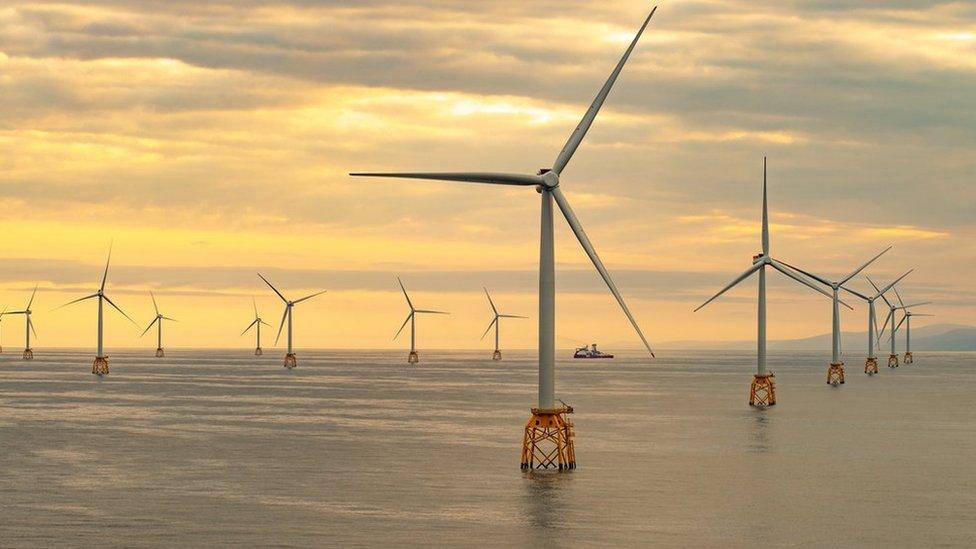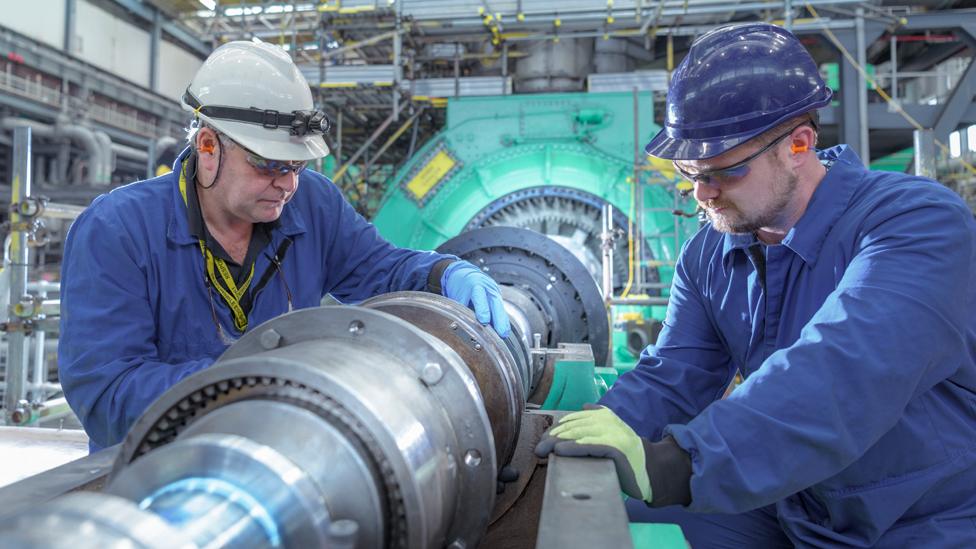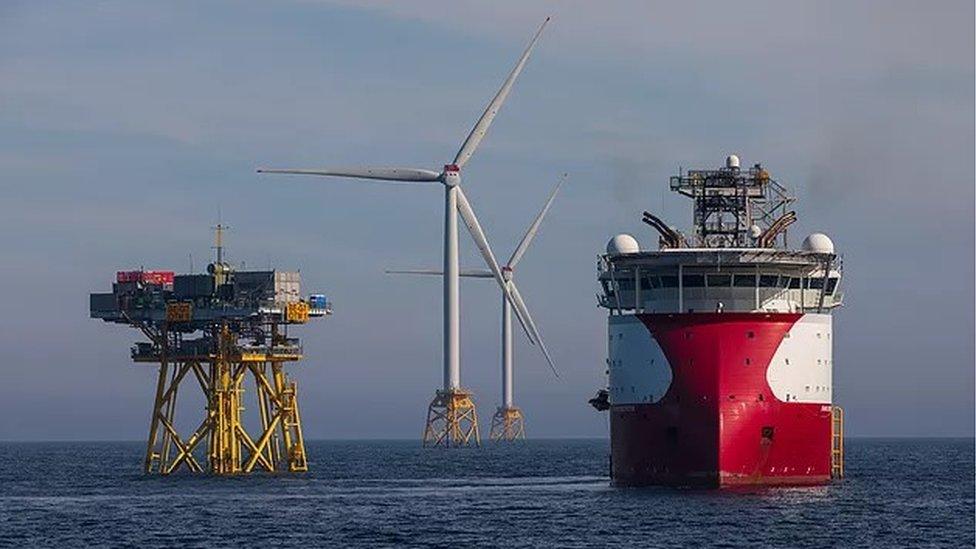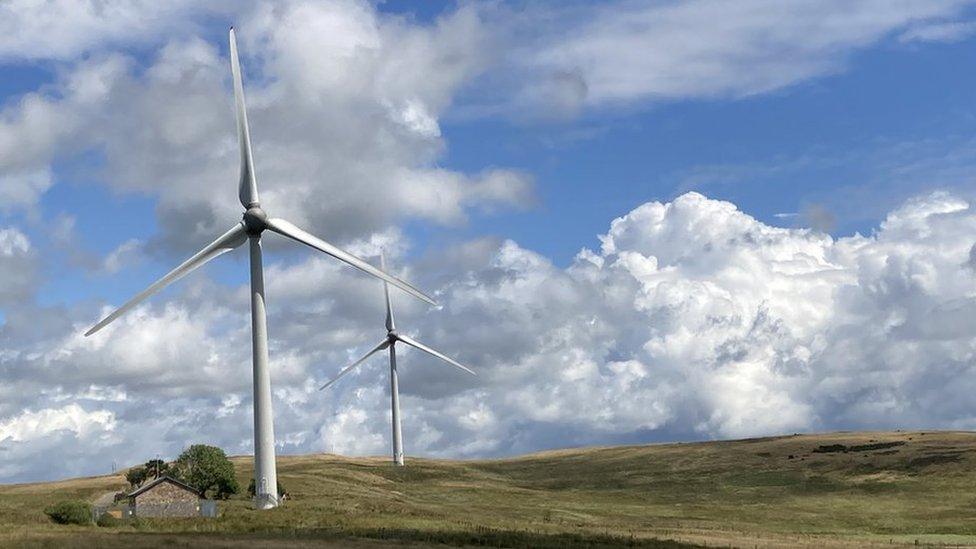Which areas of the UK's energy plan will we see in Scotland?
- Published

Up to weight new nuclear facilities have been suggested by the UK government
Scotland will not bring back nuclear reactors despite nuclear power being a central part of the UK government's energy strategy. Panning differences and devolved policies mean the strategy will be different for Scotland. So where does the country stand on the key points of the UK's blueprint, external?
1. Nuclear power
Westminster has announced it plans to reduce the UK's reliance on oil and gas by building as many as eight new nuclear reactors.
However, the Scottish government has long been opposed to renewing traditional nuclear energy plants.
Planning powers are devolved, so any attempts to develop new sites could be blocked by Scottish ministers.

Scotland has one remaining nuclear power station and is unlikely to allow more to be developed
The Hunterston B plant in North Ayrshire was shut down in January, while the last station - at Torness in East Lothian - is due to close in 2028, two years earlier than planned.
UK Energy Minister Greg Hands said in March it was a pity Scottish ministers were opposed to nuclear power, saying he hoped the Scottish government would change its mind.
The Scottish government's Energy Secretary, Michael Matheson, insisted: "Our position is very clear on nuclear, we don't believe nuclear needs to be part of the future energy mix here in Scotland and we have got no intention of taking forward nuclear developments."
The UK Energy Secretary, Kwasi Kwarteng, confirmed there were "no plans to impose nuclear reactors in Scotland" in future.
2. Wind farms
The UK government aims to reform planning laws to speed up approvals for new offshore wind farms.
This was welcomed by Keith Anderson, chief executive of Scottish Power. He said: "It takes five times longer to get a project through the UK's planning system than to build it - that's got to change if we're to stand any chance of weaning our energy system off global gas and making a green future a reality."

Beatrice is an offshore wind farm off Scotland's Caithness coast and more are coming
Renewable and low carbon energy form the Scottish government's foundation for future energy systems.
It aims to produce 50 gigawatts (GW) of energy through offshore wind.
Its ScotWind auction of seabed plots for major offshore projects netted £700m.
The 17 projects cover a total of 7,000km2 which have a combined potential generating capacity of 25GW.
Steven Wheeler, managing director of SSE's renewables division, thinks the UK strategy will kickstart an infrastructure rollout across the UK.
He said: "We have plans for the world's biggest offshore wind farm at Berwick bank at 4.2 GW.
"The challenge to get that over the line is to speed up the planning process. It has taken projects between eight to 10 years to go through the planning process and yet we can build a wind turbine in one day."
For onshore wind farms the UK government wants to develop partnerships with "supportive communities" who want to host turbines in exchange for guaranteed cheaper energy bills.
3. Hydrogen energy
UK targets for hydrogen production are being doubled to help provide cleaner energy for industry as well as for power, transport and potentially heating.
In November, the Scottish government launched a £100m, five-year plan to build Scotland's hydrogen economy.

Aberdeen has a fleet of hydrogen-powered double-decker buses
Its ambition is for the technology to provide nearly a sixth of Scotland's energy needs by 2030.
The Scottish government's Energy Transition Fund was also expanded to invest £15m in an Aberdeen Hydrogen Hub which will develop on-the-ground infrastructure to support the growth of a hydrogen transport fleet and the deployment of new applications across the north east.
Oil giant BP has joined the project which hopes to create hundreds of jobs.
The Aberdeen Hydrogen Hub is to have a solar power facility connected to a green hydrogen production and refuelling facility.
Green hydrogen refers to when the gas is produced from renewable energy as opposed to methods that release greenhouse emissions.
4. Solar power

Rising energy costs have made solar panels more worthwhile
The latest Scottish government figures show at least 70,000 solar installations in Scotland in 2020.
Home Energy Scotland estimates an average three-bedroomed house in central Scotland would save £450 a year under current higher energy prices, and the cost would be paid back in 15 years.
Householders are currently waiting for up to a year to have them fitted with interest-free loans from Home Energy Scotland on offer
5. Oil and gas
The UK government strategy has committed to more North Sea oil and gas projects. The government said it recognised "the importance of these fuels to the transition and to energy security".
It said producing gas in the UK has a lower carbon footprint than that imported from abroad.

A new round of licences will be granted by the UK government
But climate advisers said UK-produced gas would be sold internationally and would barely reduce the consumer price.
According to the Climate Change Committee, new fossil fuel projects in the North Sea would, in some cases, not deliver gas until 2050.
Friends of the Earth Scotland had previously called on the government to reject all new oil and gas projects due to the environmental impact of burning fossil fuels.
The Scottish government expects a further leasing round on oil and gas from the UK government.
Michael Matheson agreed these would continue to be an important part of the energy mix but said: "We need to accelerate our decarbonisation, our reliance on fossil fuel such as oil and gas."
He said the energy systems of the future would focus on offshore renewable potential and moving towards that through Scottish government policies including ScotWind would deliver that.
Mr Matheson added that it was the Scottish government's position that any new oil and gas reserves would need to be compatible with net zero objectives.
6. Heat pumps
The UK government has promised a £30m "heat pump investment accelerator competition" to make British heat pumps.
Heat pumps can replace household gas systems but are expensive to fit.
While householders in England and Wales will be able to apply for a £5,000 grant from April, a cashback scheme worth £7,500 is already in place in Scotland.
But the profitable Renewable Heat Incentive, which paid homeowners based on how much heating they produced, recently ended with the financial year.
The potential savings have grown to £261 per year, compared with just £43 per year under the previous price cap.
For those replacing an oil-fired system, the savings could be as high as £607 per year.
- Published7 April 2022

- Published7 April 2022
- Published29 July 2019

- Published28 March 2022

- Published25 October 2021

- Published28 November 2022

- Published15 July 2019
